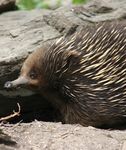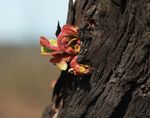Native trees in burnt areas - Fact sheet | January 2020 - Natural Resources SA
←
→
Page content transcription
If your browser does not render page correctly, please read the page content below
Native trees in burnt areas
Fact sheet | January 2020
This enormous, hollow-bearing tree is hundreds of years old. It continues to grow and provide food and shelter for wildlife despite having been through
numerous fires. Importantly, this old tree provides unique habitat that none of the other trees in the background offer.
In the weeks and months immediately after a Our trees look dead, will they recover?
bushfire, affected landholders commence the Eucalypts are well adapted to bushfires and have an amazing
major task of clean-up and repair. capacity to recover quickly. Even severely burnt trees that might
initially appear dead will be actively recovering, however this
It is during this time that some people seek to clear native trees activity occurs out of sight, beneath the bark! The first signs of
that have been burnt or scorched during the fire. Eucalypt trees recovery can usually be seen after a few months when new leaves
found in the Mount Lofty Ranges region are well adapted to push their way out from beneath the blackened bark. Known as
bushfires and most will continue to grow normally following a epicormic growth, new shoots emerge from the trunk and base of
fire. This means that unless a specific tree poses a safety risk, it is the tree. During this time it is important to control the total grazing
much better for the recovery of our native flora and fauna to pressure to give regrowth and seedlings a chance to establish. See
retain as many trees as possible. our web page on ‘Land, livestock and pasture care after fire’.
Eucalypts with rough or stringy bark may appear to have been
more severely burnt than trees with smooth bark. However this
doesn’t affect their ability to recover from fire as bark can protect
You can help your local environment the inner layers of the tree, and does not make them more likely
to collapse. In the following months it may become apparent
recover from fire by allowing native (when all other trees have resprouted) that some trees haven’t
trees to remain in the landscape and survived. Trees that don’t recover from fire are likely to be those
naturally regenerate that are under some other ‘stress’ (e.g. from prolonged drought,
soil diseases, excess soil nutrients from fertiliser etc.). However,
even dead trees provide important habitat so they shouldn’t be
removed unless absolutely necessary.2 | Native trees in burnt areas
What about dead trees or fallen timber? low branches as they can help connect fine fuels below a tree
with the tree canopy. Any trees within 20 metres of your home
Dead trees and fallen timber are also essential aspects of the
should not overhang the house and it’s recommended to have
landscape and play an important role in recovery from bushfire.
spaces between tree canopies. But remember trees are not your
After a fire the vegetative understorey is removed and therefore enemy. They can trap embers, reduce wind speeds and act as a
small fauna species can be particularly vulnerable to predation. radiant heat shield’ (source: CFS booklet ‘Your guide to bushfire
For native wildlife, dead trees and fallen timber can therefore safety’). For further information about managing native
provide the required structure to allow refuge and foraging vegetation to reduce bushfire risks, refer to the CFS website:
opportunities in the fire scar. One of our last remaining small www.cfs.sa.gov.au.
marsupials in the Adelaide Hills, the Yellow-footed Antechinus,
use these particular sites preferentially, as do echidnas, who use
fallen hollow logs for shelter.
Dead trees and branches still retain their hollows which are
features that our declining Mt Lofty woodland birds rely on (e.g.
brown treecreeper). And tawny frogmouths love hunting from
dead branches as it gives them the perfect vantage.
Logs and branches can also slow wind speeds, provide cover and
protection to native flora and trap seeds. These seeds will later
germinate and grow to help stabilise the soil, shade the soil
surface and reduce soil water evaporation.
Are trees significant fuel for bushfires?
In a bushfire, the most significant fuels are in fact ‘fine fuels’ such
as grass, leaves, bark and twigs, that are less than 6 mm in
diameter. Fine fuels catch fire easily when dry and ‘carry’ a fire. To
reduce bushfire risks, it is important to manage debris and
vegetation that makes up these fine fuels near your home and
Watch with wonder as new eucalypt leaves push their way out from
around other assets. In areas around assets, you may need to trim beneath burnt bark
Why are trees important?
Trees are a critical part of our landscape.
They provide important habitat for native
animals like birds, possums and micro-bats (small
insectivorous bats). Much of this wildlife plays
an important role in keeping insect populations
in balance. This is important for the natural
environment and agricultural production. Trees in
agricultural landscapes also provide shelter for stock
and help reduce soil erosion. Trees that contain
hollows are especially important because many
native animals, including threatened species like the
yellow-tailed black cockatoo, require these hollows
to shelter and nest in. Hollows develop as trees age
and are often only present in large trees that are
over 100 years old. This makes these trees and their
hollows irreplaceable in our lifetime, particularly
in areas like the Adelaide Hills where many of the
larger trees were historically logged.
Keeping fallen logs and branches provides cover from predators for
short-beaked echidnas and will also provide protection and habitat for
invertebrates, which are an echidna’s food source3 | Native trees in burnt areas
Dead trees are
an important
tool in helping
your land and
native wildlife
recover
A local insectivore, the Owlet-nightjar, peers out from the safety of its tree hollow home. Photo: Danny McCreadie
Are burnt trees dangerous? Can I collect fallen timber?
Only a small proportion of eucalypt trees that are burnt will Where possible, fallen timber from native trees should be left on
collapse or drop branches during or after a fire. To determine if a the ground as habitat. As mentioned, fallen timber provides shelter
burnt tree is a hazard you need to consider: and foraging places for native animals, it shelters young seedlings
• the likelihood of the tree or a portion of it falling and small plants from heat and drying winds and is important in
the recycling of nutrients. In recognition of the valuable habitat
• the chance of it causing significant damage or injury
provided by fallen timber, its removal from roadsides is prohibited
if it does fall (i.e. trees that are not close to houses or work
in most local council areas under the Local Government Act 1999.
areas are unlikely to cause damage even if they do fall).
If you are concerned about a tree, a qualified arborist will be able
to provide advice on whether it is likely to be a risk or not.
Is it legal to clear burnt or dead trees?
To conserve the health of our environment and its biodiversity,
native trees and bushland are protected under the Native
Vegetation Act 1991.
• In the Adelaide Hills region, if a tree is native and dead
(burnt inside and out, and structurally damaged), regardless
of the height, it can be removed. However, in other regions
there are restrictions about which dead trees can be
removed based on the tree’s circumference. Contact your
local Natural Resources Centre for more information.
• It is important to keep in mind that many native trees that
look dead will regenerate, in which case approval is required
to remove it. If the tree is burnt, but regenerating, dead
limbs can be pruned.
• Detail on clearing vegetation for fire hazard reduction, and
what is permitted, is on the CFS website, under the Native
Vegetation Management section: www.cfs.sa.gov.au.
• For all other clearance questions related to living trees please
contact your local Natural Resources Centre (contact details
in this fact sheet).
A regenerating tree one month after fireFurther information, contact your local
Natural Resources Centre:
Gawler (08) 8115 4600
Black Hill 8336 0901
Willunga 8550 3400
www.naturalresources.sa.gov.au/adelaidemtloftyranges/
Photo: Clive Furler
FIS95964You can also read
























































